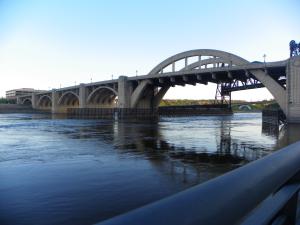
I wonder at wide water's engineers,
With skillful knowledge of long span techniques,
That settle steel or stone on several piers
Creating mighty structures, quite unique,
That bridge across a river or a creek.
They oft' display the useful Roman arch.
Their methods bear a measure of mystique,
As graceful curving columns stately march
Across the current meant to overarch.
Where do these geniuses obtain such skills?
They seem to have the wisdom Titans parch,
To keep mankind apart between two hills.
It likely was a fallen tree we owe
That bridged the gap above first water flow.
|
Author Notes
It is impossible to pinpoint the moment that bridges were invented. No individual is given credit for the discovery of a means to safely cross chasms. Since the time man first discovered a fallen tree over a river, the art and technology of building bridges has developed, expanded, and thrived. Notable landmarks in the evolution of the bridge include the Romans use of stone to build aqueducts. Around 1777, the first iron bridges made their appearances.
In Mythology, bridges were a creation of the gods, as a bridge symbolizes the pathway to paradise. The Islamic religion believes in the Sirat or "the path of God". In the Inca tradition, Hanan Pacha, their version of heaven, was accessible only over a bridge woven from hair. Japanese Shinto religion gives the floating bridge of heaven, which connects to the home of the sky gods. The Bridge of Judgment in the Zoroastrian belief has the soul met either by a beautiful maiden, or ugly hag. Norse tradition has Heimdall, who guards the bridge Bifrost. It is covered with flame to keep those unworthy from entering, unless he blows his horn to let them pass. Native American plains tribes have Owl Woman guard the bridge to the afterlife. On the Malay Peninsula, the Meni Kaien have the tradition of Balan Bacham or the bridge of the dead, guarded by Mampes. The Persians have Rashnu who, along with Mithra, and Sraosa, guards the bridge to heaven, Chinvat. These are the Titans that I refer to in my poem. Of course, the hills are heaven and earth.
This poem is a Spenserian Sonnet.
A variant on the English Sonnet form is the Spenserian Sonnet, named after Edmund Spenser (1552 -1599), in which he uses an interlocking rhyme scheme of:
abab, bcbc, cdcd, ee.
A Spenserian Sonnet does not appear to require that the initial octave set up a problem that the closing sestet answers, as with a Petrarchan sonnet. Instead, the form is treated as three quatrains connected by the interlocking rhyme scheme and closed by a couplet. The linked rhymes of his quatrains suggest the linked rhymes of such Italian forms as the Terza Rima that uses interlocking Tercets. It creates a lovely pattern that stretches out the b and c rhymes quite nicely.
This photograph was taken by the author himself in May, 2011 along the Mississippi River. The Bridge is the Robert Street Bridge, connecting downtown St. Paul to West St. Paul.
|
|
